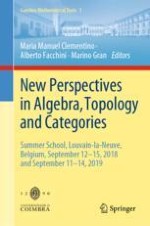This book provides an introduction to some key subjects in algebra and topology. It consists of comprehensive texts of some hours courses on the preliminaries for several advanced theories in (categorical) algebra and topology. Often, this kind of presentations is not so easy to find in the literature, where one begins articles by assuming a lot of knowledge in the field. This volume can both help young researchers to quickly get into the subject by offering a kind of « roadmap » and also help master students to be aware of the basics of other research directions in these fields before deciding to specialize in one of them. Furthermore, it can be used by established researchers who need a particular result for their own research and do not want to go through several research papers in order to understand a single proof. Although the chapters can be read as « self-contained » chapters, the authors have tried to coordinate the texts in order to make them complementary.
The seven chapters of this volume correspond to the seven courses taught in two Summer Schools that took place in Louvain-la-Neuve in the frame of the project Fonds d’Appui à l’Internationalisation of the Université catholique de Louvain to strengthen the collaborations with the universities of Coimbra, Padova and Poitiers, within the Coimbra Group.
